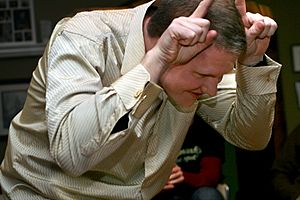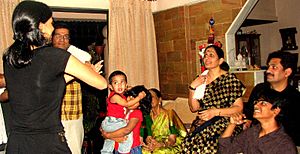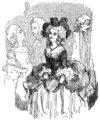Charades facts for kids
Charades is a super fun guessing game! You play it with friends or family at parties. The main idea is to act out words or phrases without speaking. Others have to guess what you're trying to show.
Long ago, Charades was a bit different. One person would act out each part of a word, like each syllable. Then they'd act out the whole word. People would guess as they went along. Sometimes, teams would act out whole scenes!
Today, when you play, you usually can't talk at all. You have to use only your body and gestures. This means you need to be creative! People often use funny actions or visual puns (like acting out "eye-scream" for "ice cream").
Charades has even been on TV! Shows like Acting Crazy and Party Game were based on this exciting game.
How to Play Charades
Charades is an old game, so the rules can change a lot. It's always a good idea to talk about the rules before you start playing! This makes sure everyone knows what to do.
Here are some common ways people play Charades today:
- Teams: Players usually split into two or more groups.
- Secret Words: One team writes down words or phrases on paper. These are the secrets the other team has to act out. You might only use words from a dictionary or names of movies or books.
- Silent Acting: The player acting out the word must do it silently. They can't speak, mouth words, spell things out, or point to letters. They also can't hum or clap. This makes sure they only use actions!
- Timer: Most games use a clock or timer. This limits how long a team has to guess the word.
- Scoreboard: Keep track of points! A team gets a point for every word they guess correctly. The other team gets a point if the first team can't guess their word in time.
- Taking Turns: Teams take turns acting and guessing. Everyone usually gets a chance to act at least once.
Common Charades Signals
When you play Charades, people often use special hand signals to help others guess. Remember, some games might not allow all of these!
- Number of Syllables: At the start, hold up fingers to show how many parts (syllables) are in the word.
- Sounds Like: Point at or tug on your earlobe. This means "the word sounds like" something else.
- Shorter Word: Move your hands or fingers closer together without touching. This means the word is shorter.
- Small Word: Hold your hands or fingers very close together. This is for small words like "the" or "of" that are hard to act out alone.
- Longer Word: Move your hands or fingers farther apart. This means the word is longer.
- Getting Close: Make a "come here" gesture or spin your hands in circles. This means "you're close!" or "keep guessing!"
- More/Suffix: Stretch out your hands like you're pulling a rubber band. This means "more" or "add a suffix" (like -ing, -ed).
- "I": Point to your chest or your eye.
- Correct Guess: Point at your nose with one hand and then point at the person who guessed correctly. This means "on the nose" or "exactly right!"
Images for kids
-
The Triumph of Clytemnestra
-
Becky as a Louis-Quatorze Philomela
See also
 In Spanish: Charadas para niños
In Spanish: Charadas para niños






